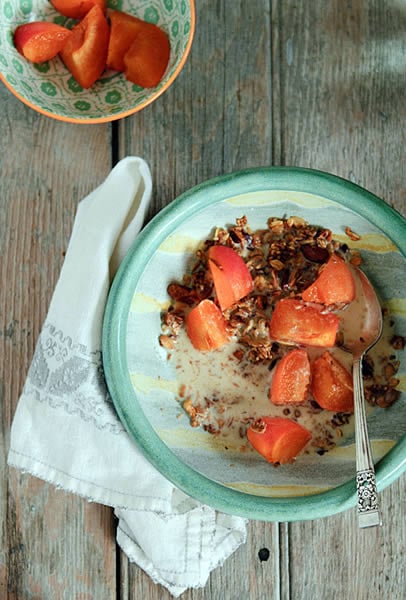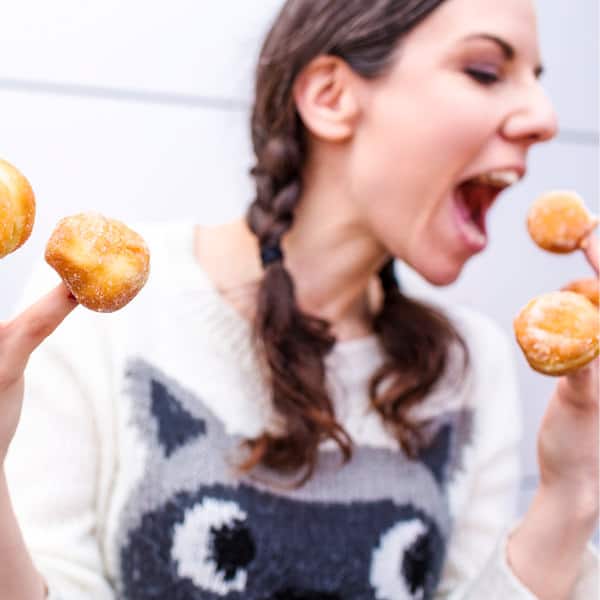Ten Ways to Save Money on Unprocessed Food (And a Nutty Olive Oil Granola Recipe)
Oct 03, 2012, Updated Sep 28, 2017
Winnie Abramson writes at Healthy Green Kitchen, where she shares her passion for real foods, healthy home cooking, and green living. She lives in New York’s Hudson Valley with her husband and two kids, plus their dogs, cats, turtles, chickens, and honeybees. She has a degree in naturopathic medicine…and a blackbelt in karate. You can also find her on Twitter and Facebook.
This is a guest post for October Unprocessed. If this is your first time here, welcome – and it’s not too late to join in! Click here to learn more.

If you have made a commitment to a eating unprocessed, you may be worried that your food bills will skyrocket. While it is true that organic produce costs more than conventional produce, raw and organic dairy costs more than pasteurized dairy, and organic and grass-fed meats cost more than factory-farmed meats, here are 10 ways you can save money on your unprocessed adventure.
1. Eat at home. Meals prepared at home are almost always better quality and are definitely less expensive than meals out.
2. Eat less meat, so that you can put your money toward better (preferably grass-fed/organic) meat when you do. Consider purchasing grass-fed meat in bulk directly from the farmer (it’s usually very reasonably priced if you do this): visit Eat Wild for a directory of grass-fed farms.
3. Skip going out for tea and coffee. You’ll save a lot of money (and you’ll do your health and the environment a favor) by preparing your own organic and fair trade varieties as home. Plus, if you make coffee and tea at home, you won’t be tempted to buy the processed pastries staring you down at your favorite cafe.
4. Start a garden. Though it might cost a bit to get a garden up and running, you’ll love having “free” organic produce a stone’s throw away once it’s established. Food stamps can be used to buy plants and seeds (visit Snap Gardens to learn more). If you don’t have space or the time for a garden, signing up for a CSA (community supported agriculture) farm-share can be a great value, especially if you split your share with someone else. To learn more about CSAs, visit Local Harvest.
5. Learn how to preserve fruits and vegetables from your own garden, CSA, or the farmer’s market. Preserving can be both economical and fun: I’ve got a pantry full of pickles, jams, jellies and sauces I made this summer to enjoy all winter long. Homemade preserved foods also make great (inexpensive!) holiday gifts for family and friends.
6. Consider joining a co-op that allows you to order directly from a natural foods distribution company. Items are typically ordered by the case so it is a good way to buy larger quantities of healthy staple items, canned and jarred goods, and all-natural body care items that you use frequently at discounted prices. You can also purchase large quantities of grains, beans, nuts and seeds this way, and you can split the large quantities with other members of your co-op.
7. Take advantage of sales. Large supermarkets as well as health food stores are always running various sales, so take advantage of these whenever you can. When organic butter and frozen fruit are on sale, for example, I stock up, then keep them in the freezer.
8. Buy what you can in bulk: nuts, seeds, grains, and dried beans are best purchased this way. This cuts down on packaging, so it’s better for the environment, but buying in bulk also saves money. Beans in particular are much less expensive if you buy them dried (and soak and cook them yourself) instead of in cans.
9. Learn to prepare items that are easy to make at home, but which can be pricey when store-bought. These include things like granola (see recipe below), vegetable, chicken, and beef stocks, and kombucha.
10. Be realistic about your budget. Don’t buy all organic produce if you can not afford it. I feel it’s really important to buy organic for the produce that’s known to contain the most pesticides (you can find these items on the Environmental Working Groups’s Dirty Dozen List). For other foods, it might make more sense to just buy local conventional fruits and vegetables, and clean them well with a produce wash: the benefit of eating whole foods far outweighs the negatives of them not being organic.

Nutty Olive Oil Granola Recipe
Ingredients
- 6 cups organic rolled oats, use certified gluten-free oats if you must avoid gluten
- 1 cup organic shredded unsweetened coconut, unsweetened coconut
- 1 cup chopped almonds, I used roasted, sea salted almonds
- 1/2 cup skinned chopped hazelnuts
- 1/2 cup raw sunflower seeds
- 1/2 cup raw sesame seeds
- 3/4 cup olive oil
- 1/2 cup honey, I used a local clover honey
- 1/2 cup demerara, or other non-refined sugar
- 1 tablespoon ground cinnamon
- 1 tablespoon pure vanilla extract
- 1 teaspoon fine sea salt
Instructions
- Preheat oven to 350°F. Line a rimmed baking sheet with parchment paper.
- Place oats, nuts, and seeds in a very large bowl. Add the olive oil, honey, sugar, cinnamon, vanilla, and salt and use a wooden spoon or your (very clean) hands to mix everything together (note: if you measure and pour the olive oil before the honey, the honey will slide right out of your measuring cup).
- Spread the granola evenly onto your parchment-lined baking sheet: you will have a thick layer. Press the granola down firmly...I think this helps it clump.
- Place the baking pan in the oven and bake for about 15 minutes.
- Rotate your pan (you can stir the granola around at this point but I didn't) and bake for another 15 minutes, or until the granola is golden brown on top and it smells amazing.
- Leave granola to rest in the pan for at least an hour or as long as overnight (covered tightly with foil) before breaking it up and transferring it to an air-tight container(s) for storage. I store my granola in a giant Mason jar, but smaller glass jars can be used at well; you can freeze some if you don't think there's any chance you'll eat up the whole recipe in the near future.





















Thanks for the great advice! I always buy local produce with my reusable produce bags made of organic cotton. Looks cool also on my kitchen table.
Unfortunately I already do all these things, I have for a long time, but still find it outside my budget to buy organic produce, meat or anything found in the “healthy food” aisle at the grocery store (I can’t walk into Whole Foods without my checkbook bouncing). The one saving grace was the Sunflower Market. They do yearlong farmer’s market type things & their fresh, local produce was CHEAPER than the grocery store! Unfortunately, they too have been bought by the local chain. Their prices slowly inched up throughout the “transition”. I just want to scream when I see their new signs that say how cheap they are when I just went in there the month before & were half that with the old local people. Another bummer is that farmer’s markets have turned into the middle-age wannabe hipster hangouts & are disgusting in their prices ($1+ for a clove… Read more »
Excellent advice regarding healthy food choices. As a city dweller, I’ve become an avid fan of Community Supported Agriculture. Here, in Toronto, I get my CSA box every week filled with seasonal and organic veggies and fruits as well as fresh eggs and dairy from local farmers. Meat may be available as well. The box with produce picked perhaps a few hours ago lands in front of my door along with some recipes of the week offering some simple and tasty options for using the items in the kitchen. It’s a great way to re-connect with local farmers, land and environment, too.
Terrific tips, Winnie! I’m trying to soak beans on a more regular basis so we always have a stash ready to go. Definitely cheaper and more flavorful! Love your recipe, too. Granola is a popular after-school snack for my boys and I appreciate new ideas.
These are great tips, Winnie! I’m a big fan of buying from the bulk bin section of the grocery store. You get to purchase as much of an item as you need so it doesn’t go to waste. However, I’m not a fan of the plastic bags that the grocery stores make available for you to put in your items. Reuseit.com sells reusable produce bags, including organic muslin bags that are perfect for nuts, seeds and grains. The bags do have a slight weight impact, but you can ask the grocery store to deduct the weight of the bag from the total. There is a tag inside the bag that shows what the bag’s weight is. Here’s the section of the website that shows all of the reusable produce bags: http://www.reuseit.com/store/bags-totes-produce-bags-c-238_242.html.
Hi, great info, thanks for sharing! Question… Has anyone heard of soaking berries, apples etc in vinegar for 10 minutes to Remove pesticides & mold spores etc? Would this be an alternative to the organic cost? I would appreciate any feedback! :))
I wish I had a local farm in Temecula for raw organic milk products! Will have to look into that! My kids drink so much milk and I do buy organic at the store but they have stripped so many of the benefits of it by the time I buy it off the shelf….
Kim, I’m down in SD, but here’s a list of raw milk providers in CA – and you can buy raw milk in the store! http://www.realmilk.com/where01.html#ca
While this won’t work for everyone, we buy milk directly from the farm. 1/2 gallon of organic (raw) milk is $3.00.
Yes Katy! I buy raw milk from a farm, too. I’m jealous of your price (I pay $4.50)…
$3 is amazing! Pricing through my CSA collective is $9.55 for a half-gallon…
11. learn to Forage! This weekend I walked the hedgerows around Portland, OR and scored rosehips, figs, italian plums, japanese plums, last of the cloudberries, too many blackberries and one wasp sting. I usually ask at the nearest house, if there is one, and have had no one refuse my foraging. In fact, one house gave me a crate of heirloom apples!
How did I leave this one out? I am big on foraging, too 🙂
Here is another recipe for granola that only uses honey as the sweetener, and uses butter instead of olive oil. I’ve made it many, many times and it is delicious! Another flavor option is to add peanut butter or almond butter to the honey/oil mixture – so yummy! Experiment! http://www.100daysofrealfood.com/2010/04/04/recipe-granola-bars-cereal/
Looks like a great recipe…thanks for the link!